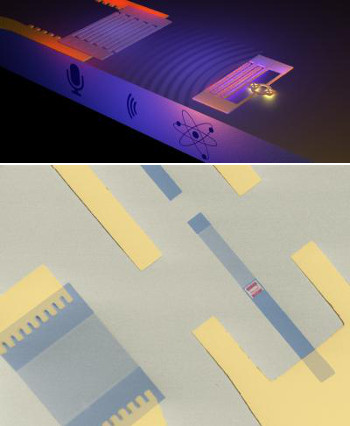
(Top) Artist’s rendering of system, with surface acoustic waves generated by artificial atom at right picked up by transducer at left. (Bottom) Microscope image showing artificial atom (red-gray spot, upper right quadrant) and transducer (blue-gray area, lower right quadrant) on chip. (Credits: top, Philip Krantz, Krantz NanoArt; bottom, Martin Gustafsson and Maria Ekström.)
Researchers at Chalmers University of Technology, Sweden, report that they have succeeded in strongly coupling surface acoustic waves to an artificial atom, and have reproduced phenomena from quantum optics, with sound taking on the role of light (Science, doi: 10.1126/science.1257219). The team believes that the slow propagation speeds of the acoustic signal could create new possibilities for controlling quantum phenomena that are unavailable to optical techniques.
Recent experiments have succeeded in strong coupling and interaction between photons in the microwave band and on-chip artificial atoms. The Chalmers team, led by Per Delsing, wanted to build a system that performed the same feat with acoustic phonons—quantized units of vibrational energy. To do so, they fashioned an artificial atom using a tiny superconducting quantum interference device (SQUID) tied to a multifingered capacitor, with the periodicity of the capacitor fingers tuned to provide the strongest possible acoustic coupling. The SQUID was placed on a microchip 100 µm away from a separate transducer that could piezoelectrically generate and receive acoustic waves that propagate across the surface of the solid chip.
The setup allowed the scientists to communicate bidirectionally with the artificial atom, “talking” and “listening” to the stream of propagating surface phonons and investigating their quantum behavior. The results showed good agreement with a quantum theoretical model. The experiments were performed at a temperature of 20 mK, on the cusp of absolute zero, to keep thermal disturbances at bay.
The Chalmers team notes that, by virtue of their slow speed and their wavelength characteristics, the use of phonons rather than photons as carriers of quantum information may allow for experiments not practical in the much faster optical realm. “By talking and listening to atoms,” says Delsing, “we have opened a new door into the quantum world.”
